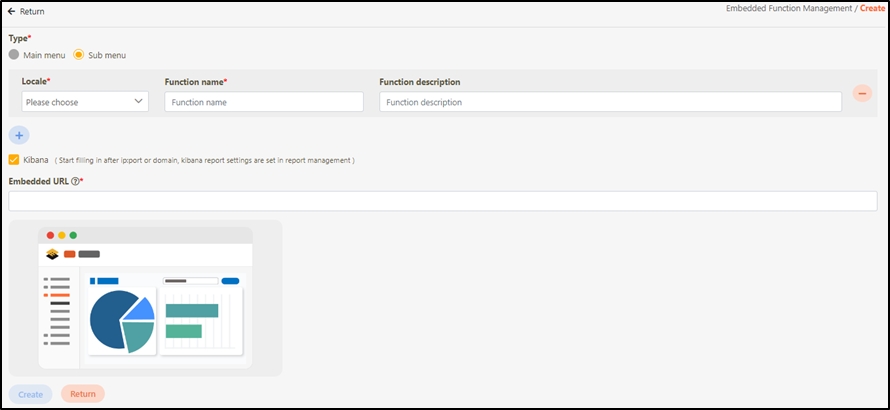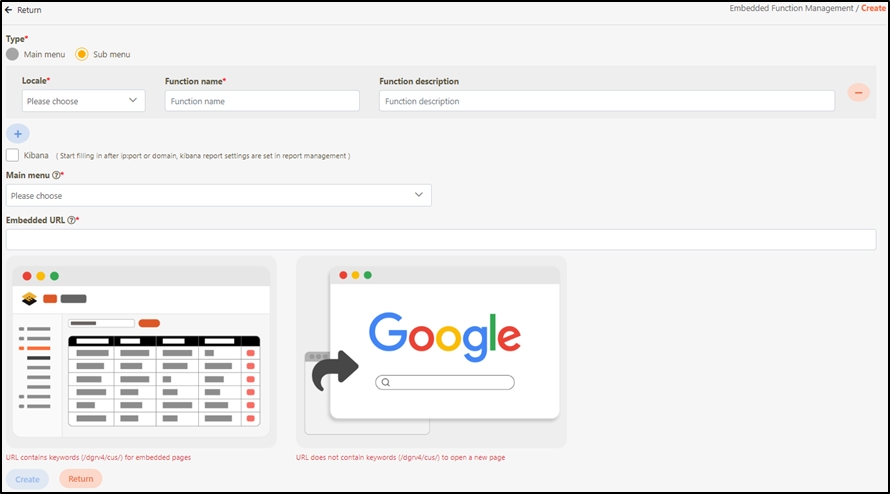Embedded Function Management
Path: Development Mode > Embedded Function Management
To add custom reports, create the report using Kibana, obtain the report URL, and paste it into this management page to dynamically display the report on the platform.

Create Embedded Function
Click Create to access the embedded function creation page.

In the Type* field, select Main menu or Sub menu, and fill in the data or make selections as instructed below. The fields marked with “*” are required.
For Main menu and Sub menu:
Locale*: The browser's locale setting that determines the language of the browser’s content.
Function name*: An identifiable function name.
Function description: A brief description of the function.
Click on the
 icon to add a new locale entry for the main menu and sub menu
icon to add a new locale entry for the main menu and sub menu

For Sub menu:
Locale*: The browser's locale setting that determines the language of the browser’s content.
Function name*: An identifiable function name.
Function description: A brief description of the function.
Click on the
 icon to add a new locale entry for the sub menu.
icon to add a new locale entry for the sub menu.Kibana: This field will be checked by default. If checked, fill in the fields as shown in the first figure below; if not checked, fill in the fields as shown in the second figure below.
Main Menu*: This field appears only when Kibana is not checked. Fill in to indicate the main menu associated with this submenu.
Embedded URL*: The linked URL, referring to either a Kibana report, an embedded page, or an external page.
The guidelines for the Embedded URL are as follows:
For a Kibana report, fill in the URL after ip:port or domain, which is fixed within the main menu's report management, and should be formatted as /kibana/1234/5678.
For an embedded page, the complete URL must contain dgrv4/cus/, its position is determined by the main menu, and should be formatted as 127.0.0.1:8080/dgrv4/cus/za0001.
For an external page, the complete URL must not contain dgrv4/cus/, its position is determined by the main menu, and should be formatted as 127.0.0.1:8080/xxxx/xxxx/za0001.
If it is a Kibana report type, do not use the formats for an embedded page or external page. Conversely, if it is an embedded page or external page type, do not use the format of a Kibana report.


Upon creation, log out and log back in to view the new embedded function.
Search Embedded Function
Enter keywords to search for the desired embedded function.

Import and Export Embedded Function
To modify multiple embedded functions at once, click Export to export the embedded functions as an .xlsx file. Modify the desired fields, click on the ![]() icon, and then click Import to import the modified file without needing to rename it.
icon, and then click Import to import the modified file without needing to rename it.
The rules are as follows:
1. Based on FUNC_CODE + LOCALE, if a duplicate exists, it will be updated; if no duplicate exists, a new record will be added.
2. This is mainly used for multilingual support.

View Roles Associated with Embedded Function
Search for the desired embedded function to view, and click on the
 icon to access the associated role page.
icon to access the associated role page.

View the roles associated with the embedded function.

Update Embedded Function
Search for the embedded function to modify, and click on the
 icon to access the update page.
icon to access the update page.

Modify the desired fields, and click Update to save and exit.

Delete Embedded Function
Search for the embedded function to delete, and click on the
 icon to proceed.
icon to proceed.

A warning prompt displaying the message “Confirm Delete?” will pop up. Click Confirm to delete the embedded function and exit.

Last updated
Was this helpful?
